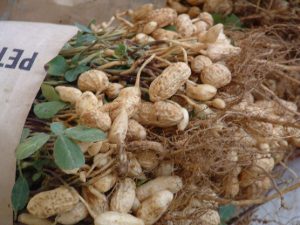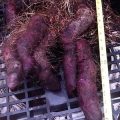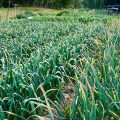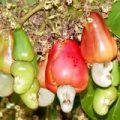Peanuts can be grown and made to bear fruit the whole year. A planter can harvest two times or more a year if this cultivation is good and the soil is fertile. Because there is always a big demand for peanuts, the planter is sure to earn. Among legumes, peanut is highest in minerals and in Vitamin B content, and has 26% protein. Every gram of peanut contains 5.4 calories. It is said that a half kilo of peanuts, more or less, equals one-half kilo of milk or three eggs of moderate size. And even if it brings high calories, it has no cholesterol.

Peanut Production Guide – Your Peanut Farming Guide
Soil and climate – Peanuts like loose, fertilizer sandy soil or porous with good permeability (that is, it does not retain water), warm climate, and an even rainfall throughout the year.
Planting – Plant peanuts in May and June if the season is rainy and between October and November if the season is dry. Summer is more favorable because in rainy weather, peanut leaves and branches are abundant, but the fruits are few. If there is irrigation, peanuts should be planted in February to be able to harvest big and plentiful grains. Peanuts may be planted along with other crops, for instance, watermelon.
Land Preparation
1. Plow the field two times at two weeks interval. Harrow the field after plowing.
2. If soil drainage is not good, plant the peanut on hills.
3. Dig trenches about 50-60 cm apart if the variety of peanut is bunchy, and 70-80 cm apart if the variety spreads. If other crops will be planted together with the peanuts, make the distance one meter apart.
4. Before planting, apply rhizobium on the peanut grains to ensure that these will grow nodules that produce nitrogen in the roots. This is available at the Bureau of Soils or Bureau of Plant Industry. In a container, wet the peanut grains with water and pour the rhizobium on them. Mix well to ensure that every grain gets rhizobium. Or, add enough water to make it pasty and mix well the grains in it. If the place for planting had been planted to peanuts also before, or plants that have been applied with rhizobium in the past three years, it is not necessary to put rhizobium in the peanuts. Such plants are mongo, soybeans, and other legumes.
5. Plant the grains immediately. Plant them in hills about 2-3 grains in each hole, 20 cm apart. A hectare of land would accommodate about 90-125 kilos seeds.
6. Apply adequate fertilizer before planting the peanuts. This responds better to fertilizer during rainy season than during dry season. Put initial nitrogen fertilizer, 25-30 kilos per hectare before planting. But if the soil is poor and shows lack of potassium and phosphorus, experts advise to apply about four (4) bags (200 kg) of 14-14-14 before planting peanuts. Apply the fertilizer about 5 cm away from the rows of seeds at about 2-1/2 cm deep. Cover with 2-3 cm soil so that this will not disturb the seedlings growth.
7. Peanuts grains need nitrogen fertilizer, especially if it is intended to be fodder (for animals). Peanuts needs phosphorus, especially if the soil is sandy. Potassium brings about increase in grains and their oil content. The application of potassium must be deep but reachable to the peanut roots. If this is shallow, the grains will not get enough calcium, so these will not grow good grains. To make the grains full, the soil should have enough calcium. So, apply lime or dolomex in the amount advised by the agriculturist.
8. If peanut is planted in October, it will not need irrigation until December. But if this will be planted in February, it should be watered 3 or 4 times. If the soil is very dry before planting time, irrigate before planting, or water soon after planting to hasten germination. Water again when the grains begin to form.
9. When irrigating, wet the soil until about 30 cm deep. 10.Peanuts germinate in 15 days after planting. Three weeks after germination, see if the application of rhizobium has been effective. Pull up a plant, cut (dissect) the grain at the root. If the grain is pinkish, the rhizobium was effective. If it is pale or gray, it did not take effect. If the plant has no nodules in the biggest root but the plant grows well, the soil has adequate nitrogen. If the soil lacks nitrogen but the roots at the side instead has nodules, the rhizobium took effect although not sufficiently.
Thus, nitrogen fertilizer is necessary while preparing the soil for planting. If still, the peanuts do not bear good grains, then the soil is not for peanuts.
Control for pests and diseases
1. Weeds — apply herbicides 2-3 weeks before planting to keep weeds from growing. Culture the soil, but stop when the plants begin to flower, lest the grains that are starting to develop get hurt.
2. Pests and diseases attack peanuts too, like any other plant. During humid and hot climate, damage is caused, such as:
a) leaves and sometimes stalk — reddish brown or black spots
Control: apply:
– Fungitox — 1-2 spoonfuls in 5 gallons water or
– Benlate — ½ teaspoon in one gal water
b) leaves — dark orange or brown blisters under the leaves at the latter part of growth. This is the sign of peanut rust.
Control: Dithane M-45 — 2 teaspoons for every gal of water
– Plant vax — ½ teaspoons for every gal of water
– Spray 3 times at the time of growth, with 10-14 days interval
c) wilting of leaves, stalk and sometimes the whole plant.
Control: Spray with Vitigran Blue 35 WP — 3 tablespoons in 5 gal at first sign of infection or before it sets. Repeat 1-2 weeks between, remove diseased parts.
d) Rosete — disease spread by aphids. Small round yellow spot, leaves curls up at the end.
The next set of leaves have colorless stripes. When this becomes serious, the plant stops growing and leaves form in clusters like roses. The disease enters the grains which starts its spread in the field. To avoid, do not use seeds from diseased plants. Consult technicians from BAEX or the Bureau of Plant Industry for problems like this.
Harvesting
Peanuts mature within four months after planting. It is ready for harvest when the leaves wilt and turn yellow if planted in summer. This is also known if the shell of the peanut is hard. Pull up about ten plants, open and see the shell of the grain. If there are dark streaks or roots inside the shell, the peanut is ready for harvest. If the peanut is not mature, the shell is shriveled. If it is over matured, this roots in the soil, or starts to germinate.
1. Pull up the plants with the help of a spade or fork, or plow the two sides of the rows before pulling them up. Stack up the harvest in a dry place and air the peanuts.
2. Newly harvested peanuts contain 50-55% water. If this will be dried in the sun, dry them until the humidity is about 12%. If it will be stored in a closed container, dry until 6-8% humidity.
3. Carefully remove the kernels from the shell do not allow them to be broken or their seed cover by bruised. This will be the start of rotting.
It is better to store peanuts with their shell to avoid pest destruction. If watermelon is planted together with the peanuts, this will be harvested earlier by one month. But it will go on bearing fruit after the first harvest. The body of the watermelon plant will remain in the field until the peanuts are harvested.
source: elgu2.ncc.gov.ph







oour company is in need of raw peanuts…do you any referrla for peanut plantation..tnx so much
Online jobs -data encoder . Part time/full time
You can earn while enjoying time with your family and love ones.
for more details, kindly visit http://www.unemployedpinoys.com/
to get started., Email me at besbremisana@yahoo.com